Table of Contents
Are you ready to dive into the exciting world of hydroponics? If you’re unfamiliar, where plants grow in a water-based nutrient-rich solution instead of soil. Hydroponics provides a controlled environment that allows for optimal plant growth and production. But to achieve this, it’s crucial to understand the right nutrient solution ratios that ensure plants receive the nutrients they need to thrive.
Why are Nutrient Solutions Important in Hydroponics? In hydroponic systems, plants rely entirely on nutrient solutions to receive the essential minerals and nutrients required for growth. These solutions contain a mixture of macro-nutrients (like nitrogen, phosphorus, and potassium) and micro-nutrients (like iron, zinc, and copper), necessary for healthy plant development.
So, what are nutrient solution ratios, and why are they so important? Nutrient solution ratios refer to the proper balance of nutrients that plants need for healthy growth. In other words, it’s like a recipe for plant food! The optimal nutrient solution ratio can vary depending on the type of plant, the growth stage, and the environmental conditions. Using an incorrect ratio can result in undernourished or overfed plants, leading to stunted growth, reduced yield, and even death. Hence, understanding the right nutrient solution ratio is critical for successful hydroponic gardening.
Are you excited to learn more about nutrient solution ratios and how they impact plant growth? Let’s get started!
What are Hydroponic Nutrient Solutions?
A hydroponic nutrient solution is a mixture of water and essential minerals that provide plants with the necessary nutrients for growth. Hydroponic nutrient solutions are the backbone of any successful hydroponic system. These solutions contains 17 essential nutrients. These essential nutrients are broadly categorized as macro-nutrients and micro-nutrients.
The essential elements for plant growth in Hydroponics are:
Macro-nutrients
- Nitrogen (N)
- Potassium (K)
- Phosphorus (P)
- Calcium (Ca)
- Magnesium (Mg)
- Sulphur (S)
Micro-nutrients
- Iron (Fe)
- Manganese (Mn)
- Copper (Cu)
- Zinc (Zn)
- Molybdenum (Mo)
- Boron (B)
Optional
- Chlorine (Cl)
- Nickel (Ni)
- Cobalt (Co)
- Silica (Si)
- Selenium (Se)
The composition of a nutrient solution can vary depending on the specific crop being grown, as well as the stage of growth. For example, plants in the vegetative stage require higher levels of nitrogen to support leaf and stem growth, while plants in the flowering stage require higher levels of phosphorus to support the development of flowers and fruits.
In hydroponic systems, plants absorb nutrients directly from the nutrient solution through their roots. This means that the composition and quality of the nutrient solution can have a significant impact on plant growth and yield. To ensure that plants receive the optimal amount of nutrients, it is essential to maintain the correct ratios of macronutrients and micronutrients in the nutrient solution.
Importance of pH and EC levels in Nutrient Solutions:
Maintaining the correct pH and electrical conductivity (EC) levels in the nutrient solution is critical for plant growth. pH levels can impact nutrient uptake, and if the pH is too high or low, the plant may not be able to absorb all the necessary nutrients. Most plants prefer a slightly acidic pH level between 5.5 and 6.5, and adjusting the pH of the nutrient solution is essential to maintaining the ideal environment for plant growth.

EC levels, on the other hand, measure the concentration of dissolved salts in the nutrient solution. If the EC level is too high, it can lead to nutrient burn, causing damage to the plant’s roots. Monitoring and adjusting both the pH and EC levels are crucial to ensuring that plants receive the optimal nutrient solution.
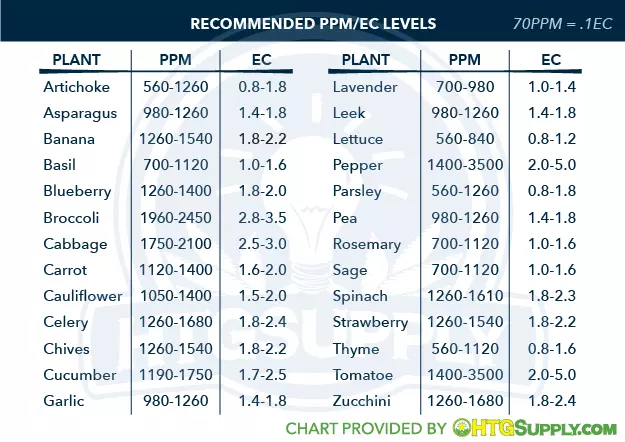
Importance of Temperature and Water Quality in Hydroponics
In addition to pH and EC levels, temperature and water quality are also important factors to consider when it comes to hydroponic nutrient solutions.
Temperature can have a significant impact on plant growth and nutrient absorption. Ideally, the nutrient solution should be kept between 65-75°F (18-24°C) for optimal plant growth. If the temperature is too low, it can slow down the plant’s metabolism and nutrient uptake. On the other hand, if the temperature is too high, it can lead to root damage and reduce the oxygen levels in the water.
Water quality is another important aspect to consider when it comes to hydroponic nutrient solutions. The water used in hydroponics should be free of contaminants such as chlorine and heavy metals, which can be harmful to plant growth. It’s important to use a water filtration system to ensure that the water is clean and safe for the plants to grow in.
In addition, the nutrient solution should be changed regularly to prevent the buildup of harmful substances that can negatively affect plant growth. The frequency of nutrient solution changes will depend on the specific crop being grown and the size of the hydroponic system.
Macro and Micro Nutrients for Optimal Plant Growth
The importance of providing plants with the right balance of nutrients cannot be overstated. While plants can respire, absorb moisture, and photosynthesize using elements readily available in the air and water, they require specific nutrients to develop properly. The two types of nutrients plants need are macro-nutrients and micro-nutrients.
Plants require a variety of nutrients for optimal growth and development, including macro and micro-nutrients. Macro nutrients, which are needed in large quantities, play a critical role in plant health and development. The primary macro-nutrients are nitrogen, phosphorus, and potassium, often abbreviated as NPK.
Macro-nutrients
Nitrogen
Nitrogen is considered the most important of all the nutrients, as it is responsible for the vegetative growth of plants, including leaves, stems, and their color. It also plays a crucial role in the formation of chlorophyll, amino acids, co-enzymes, and proteins used in new cell walls. During the growth phase, plants require a lot of nitrogen, and it is commonly used as part of fertilizers in soil and nutrient solutions in hydroponics. A lack of nitrogen results in yellowing leaves, while an excess of nitrogen leads to decreased fruit and flower production, as plants focus all their energy on producing foliage.
Phosphorus
Phosphorus is another critical macronutrient and is essential for DNA, the genetic memory unit of plants. It plays a crucial role in the development of flowering, fruits, seeds, and roots. Plants require a large amount of phosphorus during the early phases of seedling, germination, and flowering, but it is necessary throughout the entire life cycle. Plants deficient in phosphorus show signs of shorter plant growth, weak leaves, flowers, and roots.
Potassium
Potassium is required in large adequate amounts for effective development and reproduction of plants. Unlike other nutrients, it does not form compounds in plants, but it does help stimulate crucial processes, including photosynthesis, starch formation, protein synthesis, and enzyme activation. Plants that lack potassium often show yellow leaves first. When in high concentrations, potassium prevents plants from interacting with other nutrients such as zinc, iron, and magnesium.
Calcium
Calcium is also an essential macronutrient for plants as it is required for cell formation and development. Calcium deficiency can lead to the tip and edge of leaves turning brown and can cause them to die. On the other hand, too much calcium in the early phase of a plant’s life cycle can stunt its growth.
Sulfur
Sulfur is another important macronutrient for plants. It is a structural component of two of the 21 amino acids that create protein. Additionally, sulfur helps activate and form certain enzymes and vitamins in plants.
Magnesium
Magnesium is one of the chemical components of chlorophyll, which is essential for photosynthesis. It helps create oxygen through photosynthesis and is often used in large amounts in fast-growing plants.
While all of the macro-nutrients are crucial for a plant’s development, the three macro-nutrients (N, P, K) are the most important ones to take care of first.
Micronutrients
Micro nutrients are still essential for plant development, but they are required in smaller quantities compared to macro-nutrients.
Zinc
Zinc is a crucial micro nutrient in the formation of chlorophyll and other enzymes, and in nitrogen metabolism.
Boron
Boron is used with calcium in synthesizing the structure and functions of cell membranes. Additionally, it helps with pollination and seed production.
Iron
Iron is a component of many enzymes associated with energy provision, nitrogen fixation, and helps form chlorophyll. It is also used in photosynthesis.
Manganese (Mn)
Manganese catalyzes the growth process and helps form oxygen in photosynthesis.
Understanding the importance of both macro-nutrients and micro-nutrients is key to achieving optimal plant growth. It is important to note that each plant has unique nutrient requirements and ratios. The ideal nutrient solution ratios for different plant types can be achieved through careful consideration of the specific plant species, their growth stages, and environmental conditions.
In conclusion, by providing the right balance of macro and micronutrients in the nutrient solution, plants can thrive in a hydroponic system. By understanding the components of a hydroponic nutrient solution, how plants absorb nutrients in hydroponic systems, and the importance of pH, EC levels, temperature, and water quality, growers can create the ideal conditions for their plants to grow and flourish.
Here are the recommended nutrient ratios for some plant types
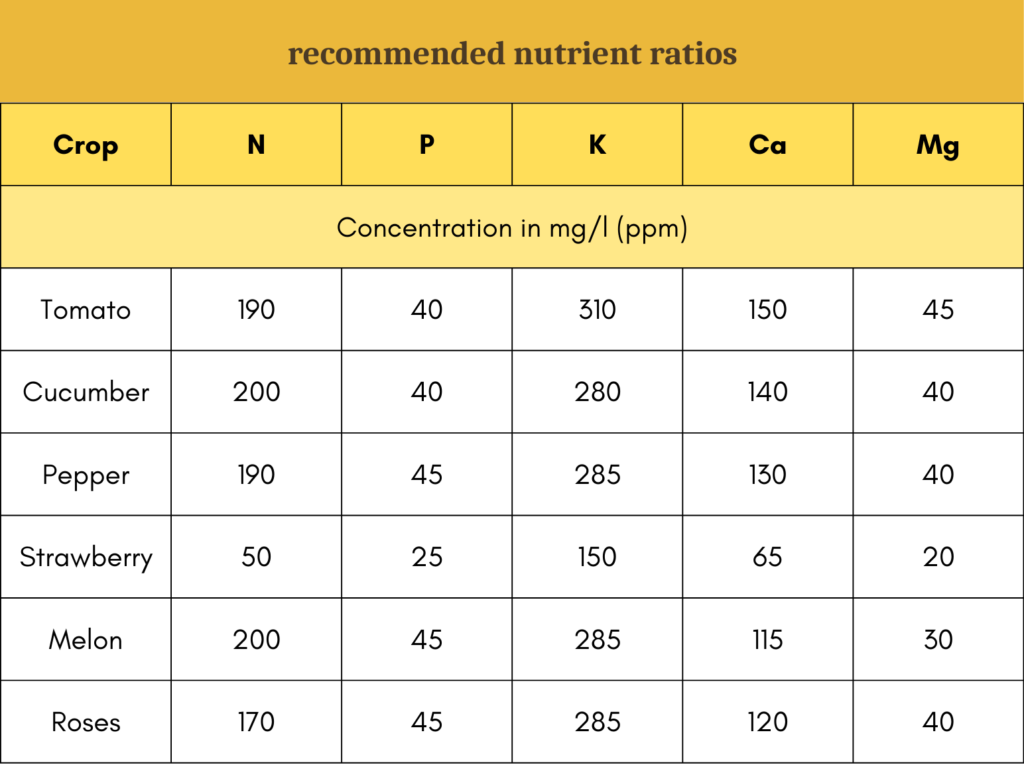
NPK Ratio:
When it comes to hydroponic nutrient solution ratios, the NPK ratio is a significant factor that determines the optimal growth of plants. NPK stands for Nitrogen (N), Phosphorus (P), and Potassium (K) – three of the most important macro-nutrients that plants need in large quantities. Each of these nutrients plays a crucial role in the plant’s growth and development.
While purchasing fertilizers, you will observe that each brand has its own NPK ratio. Just like any other product, all fertilizers are not the same. Your hydroponics efforts will surely receive a boost by understanding the different NPK ratios. Reading this ratio is not at all difficult. If a certain fertilizer has a 7-9-5 NPK ratio, it means that the fertilizer provides seven, nine, and five percent nitrogen, phosphorous, and potassium respectively. Please remember that fertilizer may contain up to twenty different plant nutrients
Vegetative State NPK Ratio:
During the vegetative stage of plant growth, the plant’s focus is primarily on leaf development, stem growth, and root formation. For this reason, the ideal NPK ratio for vegetative growth is typically higher in nitrogen (N) than phosphorus (P) and potassium (K). A commonly used NPK ratio for this stage is 3-1-2, which means 3 parts nitrogen, 1 part phosphorus, and 2 parts potassium.
Flowering Stage NPK Ratio:
In the flowering stage, plants need less nitrogen and more phosphorus and potassium to support flower development and fruit production. A commonly used NPK ratio for this stage is 1-3-2, which means 1 part nitrogen, 3 parts phosphorus, and 2 parts potassium. However, it’s important to note that different plants have different nutrient requirements during flowering, and the ideal NPK ratio may vary based on the plant species.
Other Commonly Used NPK Ratios:
Aside from the 3-1-2 and 1-3-2 ratios, there are several other NPK ratios that are commonly used in hydroponic nutrient solutions. For example, a 2-3-1 ratio is often used for fruiting plants, while a 2-1-2 ratio is suitable for foliage plants. The right NPK ratio will depend on the specific needs of the plant, its growth stage, and other environmental factors.
Commercial vs. DIY Nutrient Solutions:
When it comes to hydroponic nutrient solutions, you have two options: commercial nutrient solutions or DIY nutrient solutions. Commercial nutrient solutions are pre-made mixes that are specifically designed to provide plants with the necessary nutrients in the correct ratios. These solutions can be expensive, but they are often more convenient for beginner growers who may not be familiar with the ideal nutrient ratios for their plants.
On the other hand, DIY nutrient solutions can be made at home using various ingredients, such as fertilizers, Epsom salt, and other mineral supplements. This option allows growers to tailor the nutrient ratios to their plants’ specific needs and can be more cost-effective in the long run. However, creating DIY nutrient solutions requires more knowledge and expertise to ensure that the ratios are correct and that the plants are receiving all the necessary nutrients for optimal growth.
In conclusion, understanding the NPK ratio is critical to creating an ideal hydroponic nutrient solution for your plants. By selecting the right ratio based on the plant’s growth stage and specific needs, you can provide your plants with the nutrients they require for optimal growth and development. Whether you opt for commercial or DIY nutrient solutions, ensuring that your plants are receiving the correct NPK ratio is essential for successful hydroponic gardening.
Electrical Conductivity in Hydroponic Nutrient Solution
Electrical conductivity (EC) is a measurement of the ability of a solution to conduct an electric current. In hydroponic systems, the electrical conductivity of the nutrient solution is an important parameter to monitor. It reflects the concentration of dissolved salts in the solution, including essential plant nutrients.
Electrical conductivity can be measured using an EC meter or a TDS (Total Dissolved Solids) meter. These devices work by passing an electric current through the nutrient solution and measuring the resistance encountered. The more salts and nutrients are present in the solution, the higher the electrical conductivity will be.
The ideal electrical conductivity range for hydroponic nutrient solutions varies depending on the plant’s growth stage and plant types. During the seedling stage, the electrical conductivity should be between 0.5 and 0.8 mS/cm (milliseconds per centimetre). For the vegetative stage, the range is between 0.8 and 1.2 mS/cm. For the flowering stage, the range should be between 1.2 and 1.6 mS/cm.
It’s essential to monitor and adjust the electrical conductivity of the nutrient solution regularly. Too high electrical conductivity can cause nutrient burn, where the plant is overdosed with salts and nutrients. On the other hand, a low electrical conductivity means the plants are not getting enough nutrients and may suffer from stunted growth.
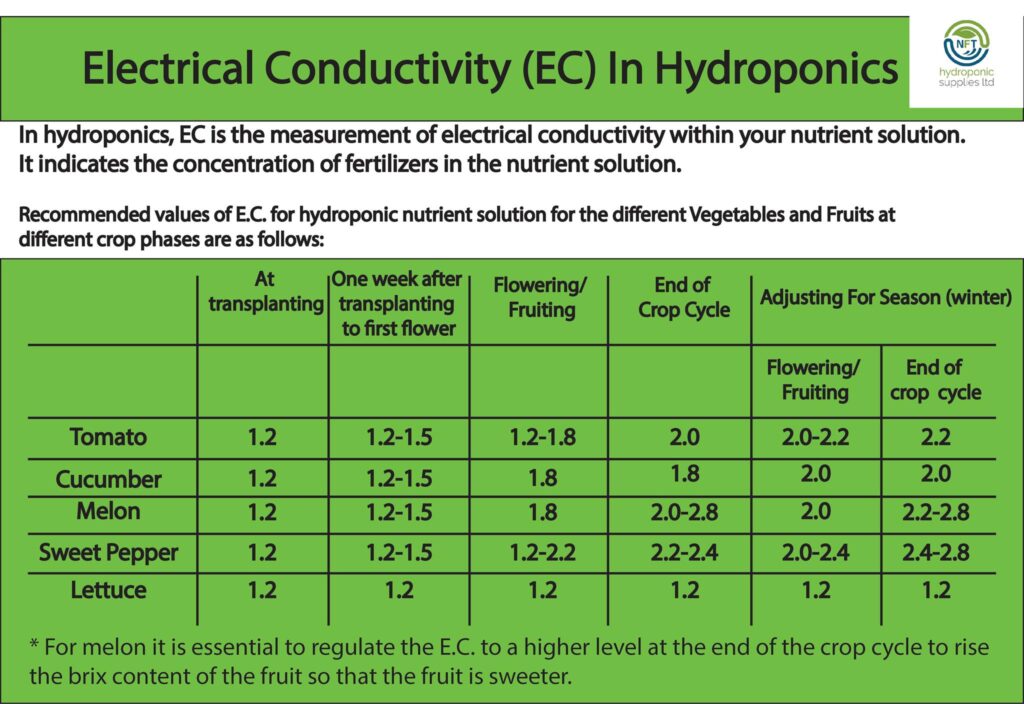
image source: Hydroponic Supplies Ltd.
EC meters or TDS meters are commonly used to measure the electrical conductivity of hydroponic nutrient solutions. EC meters measure the conductivity of the solution in milliseconds per centimetre (mS/cm), while TDS meters measure the total dissolved solids in the solution, expressed in parts per million (ppm).
It’s essential to calibrate the EC or TDS meter regularly to ensure accurate readings. Most meters come with calibration solutions that simulate specific electrical conductivity values. The calibration solution’s value should match the expected electrical conductivity range of the nutrient solution being used.
Problems in Hydroponic Nutrient Solution
Hydroponic systems rely on a carefully balanced nutrient solution to ensure optimal plant growth. However, sometimes issues arise that can cause problems for your plants. Here are some of the most common nutrient solution problems that hydroponic growers may encounter:
Nutrient deficiencies:
Plants require a specific balance of nutrients to grow properly. When they are lacking in any essential nutrient, it can lead to nutrient deficiencies. For example, a lack of nitrogen can cause stunted growth and yellowing of leaves.
If you suspect that your plants are suffering from a nutrient deficiency, the first step is to identify which nutrient is lacking. You can do this by examining the symptoms and comparing them to a nutrient deficiency chart. Once you know which nutrient is missing, you can adjust your nutrient solution accordingly.
Excess nutrients:
Just as a lack of nutrients can harm your plants, an excess of nutrients can also be problematic. Over-fertilization can cause nutrient burn, which can damage or kill your plants.
If you notice signs of nutrient burn, such as brown or yellow tips on leaves, it’s important to flush your system with fresh water to remove the excess nutrients. You may also need to adjust your nutrient solution to prevent over-fertilization in the future.
pH imbalance:
The pH level of your nutrient solution is critical for proper nutrient uptake. If the pH is too high or too low, it can lead to nutrient lockout, which prevents your plants from being able to absorb the nutrients they need.
To correct a pH imbalance, you will need to adjust the pH level of your nutrient solution. This can be done by adding pH up or pH down solutions to raise or lower the pH level, respectively.
Problems Resulting from High Temperatures of Hydroponic Nutrient Solutions:
In addition to nutrient imbalances, high temperatures can also cause problems for hydroponic growers. When the nutrient solution gets too warm, it can lead to the growth of harmful bacteria and algae. This can affect the pH level and nutrient balance of your solution, which can harm your plants. To avoid this problem, it’s important to monitor the temperature of your nutrient solution regularly and take steps to keep it cool. This can be done by using a water chiller or by moving your reservoir to a cooler location.
How To Troubleshoot Nutrient Solutions Problems:
To know more about “How to Troubleshoot Nutrient Solution Problems” Read This Blog.
Advanced Techniques for Nutrient Solution Ratio Optimization
Once you have a good understanding of nutrient solution ratios and the ideal electrical conductivity levels for your plants, you can start to explore advanced techniques for optimizing your nutrient solution.
Alternative nutrient sources:
While commercial hydroponic nutrient solutions are readily available, some growers may prefer to use alternative sources of nutrients. This may include organic sources such as compost teas or manure, or synthetic sources such as chemical fertilizers. It’s important to note that alternative nutrient sources may require more monitoring and adjustment to ensure proper nutrient ratios.
Supplemental nutrient solutions:
In addition to your main nutrient solution, you can also use supplemental nutrient solutions to provide additional nutrients that may be lacking. For example, if your main nutrient solution is lacking in calcium, you can add a calcium supplement to the solution.
Customizing nutrient solution ratios:
Depending on your plant species, growth stage, and environmental conditions, you may need to customize your nutrient solution ratios to achieve optimal growth. This can be done by adjusting the ratios of nitrogen, phosphorus, and potassium, as well as micro-nutrients like calcium, magnesium, and iron. Keep in mind that adjusting nutrient ratios too much can result in nutrient imbalances, so it’s important to monitor your plants carefully and make adjustments gradually.
By using alternative nutrient sources, supplemental nutrient solutions, and customizing your nutrient solution ratios, you can fine-tune your hydroponic system for optimal plant growth and yields. However, it’s important to remember that nutrient solution management is an ongoing process, and regular monitoring and adjustment are necessary to ensure your plants are receiving the nutrients they need.
That’s It!
Throughout this article, you have explored various topics related to hydroponic nutrient solution ratios, including NPK ratios, electrical conductivity, nutrient solution problems, and advanced techniques for nutrient solution management.
By understanding these concepts and techniques, you can customize your nutrient solution ratios to fit the specific needs of your plants, and troubleshoot any problems that may arise.
I encourage you to experiment with different nutrient solution ratios and techniques to find the perfect balance for your hydroponic garden. With a little patience and practice, you can achieve optimal plant growth and a bountiful harvest. Happy growing!



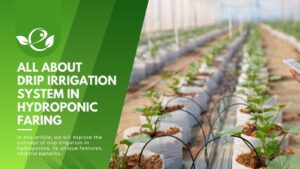


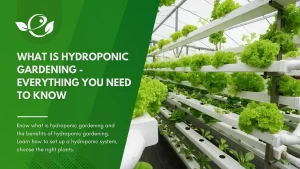

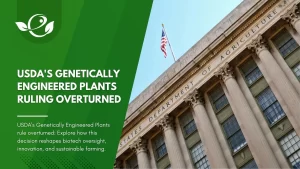
This Post Has One Comment
I’m not sure exactl why but this weblog iis loading very slow
for me. Is anyone else having this issue or is it a issue on my end?
I’ll check back laterr on annd see if thhe problem still exists. https://bandurart.Mystrikingly.com/